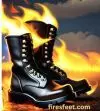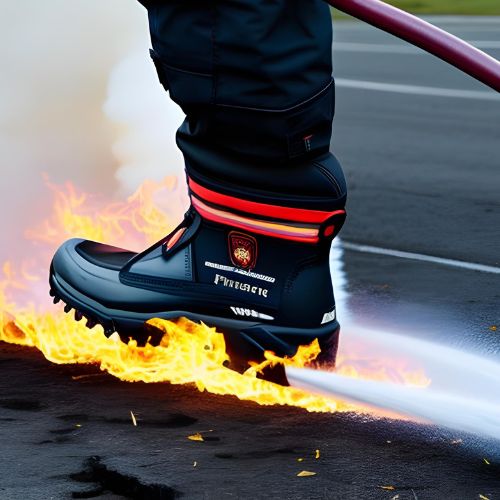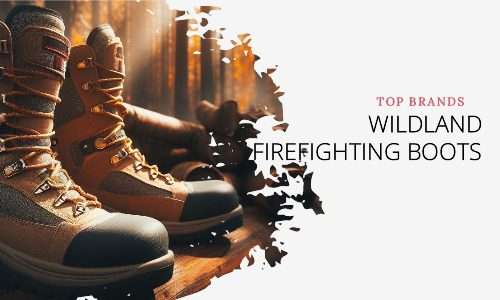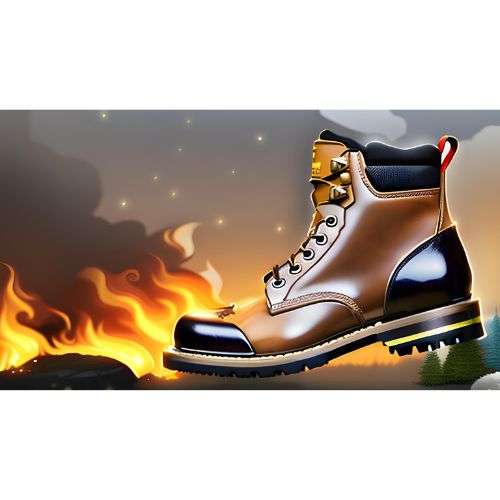Fire boots buying guide is a topic that every firefighter should be interested in. As a firefighter, you know that fire boots are not just any ordinary shoes. They are essential protective gear that can make all the difference between life and death in a fire. Designed to withstand extreme heat, flames, chemicals, and other hazards, fire boots provide unparalleled protection, support, and durability that enable firefighters to work effectively and safely in demanding conditions. But with so many options available, how can you find the perfect pair of fire boots for your needs? What features should you look for? What types of fire boots are there? And how can you maintain and care for your fire boots to keep them in top shape? This shopping guide for fire boots will answer all your questions and equip you with the knowledge you need to make an informed decision. By the end of this article, you’ll be ready to choose the best fire boots to help you perform your job with confidence and peace of mind.
Table of Contents
ToggleThe Crucial Role of Wildland Firefighting Boots
Firefighters are required to wear fire boots, as they are essential for fighting fires. Fire boots offer numerous benefits, making them a must-have for firefighters. Here are some reasons why firefighters need to wear fire boots:
Safety:
Fire boots are made of fire-resistant materials that protect the feet from intense heat and flames. They also guard against cuts, punctures, hits, and abrasions caused by glass, nails, debris, and other sharp objects. Fire boots keep the feet dry, preventing frostbite, infections, and blisters. They also protect against electrical hazards, bloodborne viruses, and chemical spills that can be harmful to health.
Comfort:
Fire boots should be comfortable and supportive for the feet, ankles, and lower legs. They have cushioned insoles, padded tongues, and collars that minimize friction and pressure points. They also have breathable linings that wick away moisture, keeping the feet cool and dry. Fire boots come in ergonomic shapes and sizes that fit well, preventing blisters and slippage. The flexible soles and shafts allow the feet to move naturally, reducing fatigue.
Traction:
Fire boots have rugged outsoles that provide excellent grip and stability on various surfaces and terrains. They have deep lugs and treads that prevent slipping and skidding on wet, oily, or uneven floors. They also have heel brakes and toe caps that enhance traction and control on slopes and stairs. Fire boots have steel shanks and arch supports that reinforce the structure and rigidity of the boots, preventing twisting and bending of the feet.
Durability:
Fire boots are built to last and withstand harsh and demanding conditions. They have sturdy construction and quality materials that resist wear and tear, prolonging the lifespan of the boots. They have reinforced stitching and seams that prevent splitting and tearing of the leather or fabric. Also, they have durable hardware and fasteners that secure the boots and prevent them from coming loose or breaking. These boots have replaceable parts and components, allowing firefighters to repair and refurbish their boots, keeping them in service for years.
Fire Boots Buying Guide: Key Features to Look for:


Type:
Size:
Material:
Certification:
How to Pick the Best Boots
Top Brands for wildland fire boots?
The market is filled with several brands and models of wildland fire boots, each with unique characteristics, benefits, and drawbacks. The best brand or model of wildland fire boots will rely on your expectations, financial situation, and personal taste. Based on the details we have shared above with you, we have reviewed and chosen some of the top models and brands of wildland fire boots to assist you in making an informed choice. These are as follows:
White’s Boots 400VLTT Smoke Jumper Lace-To-Toe Boot:
This Boot is a well-known and reputable brand that has been producing boots for wildland firefighters since a certain year (which is missing in the text). These boots are handcrafted with superior leather, steel shank, heel, and toe, and have a Vibram lug sole. They are also resoleable and NFPA certified. While these boots offer great comfort, durability, and protection, they are also pricey and bulky.
Danner Flashpoint II 10 Inch All Leather Work Boot:
 This is another esteemed brand of wildland fire boots that has been producing boots for the military and law enforcement since a certain year (which is missing in the text). This model has a Vibram Fire Logger sole, Nomex stitching, and fire-resistant leather. It is also NFPA certified and resoleable. These boots offer superior heat resistance, stability, and support, but they are also costly and stiff.
This is another esteemed brand of wildland fire boots that has been producing boots for the military and law enforcement since a certain year (which is missing in the text). This model has a Vibram Fire Logger sole, Nomex stitching, and fire-resistant leather. It is also NFPA certified and resoleable. These boots offer superior heat resistance, stability, and support, but they are also costly and stiff.
Chippewa 8” Steel Toe EH 27422 Boot:
 This is a more affordable and lightweight option for wildland fire boots. These boots are made of leather, Goodyear welt construction, and a Vibram Tacoma Logger sole. They are also NFPA certified and resoleable. While these boots offer good traction, flexibility, and comfort, they are less durable and protective than the other models.
This is a more affordable and lightweight option for wildland fire boots. These boots are made of leather, Goodyear welt construction, and a Vibram Tacoma Logger sole. They are also NFPA certified and resoleable. While these boots offer good traction, flexibility, and comfort, they are less durable and protective than the other models.
La Sportiva Glacier WLF Hiking Boot:
 La Sportiva Glacier WLF Hiking Boot is a unique and versatile option for wildland fire boots, as they are designed for both hiking and firefighting. These boots are made of leather, rubber rand, and a Vibram Ice-New sole. They are also NFPA certified and resoleable. These boots offer great breathability, cushioning, and grip, but they are less fire-resistant and supportive than the other models.
La Sportiva Glacier WLF Hiking Boot is a unique and versatile option for wildland fire boots, as they are designed for both hiking and firefighting. These boots are made of leather, rubber rand, and a Vibram Ice-New sole. They are also NFPA certified and resoleable. These boots offer great breathability, cushioning, and grip, but they are less fire-resistant and supportive than the other models.
Handmade wildland fire boots:
What are the best fire boots for women?
When it comes to fire boots, women firefighters have distinct needs and preferences than men firefighters. Women’s feet are smaller, narrower, and more arched than men’s feet, so they require fire boots that are tailored to their anatomy and biomechanics. Women also have more sensitive skin and nails, necessitating the use of fire boots that are both comfortable and breathable.
Unfortunately, there aren’t many women’s fire boots available. Most fire boots are unisex, which means they are based on men’s sizes and forms and may not suit women well. However, there are some fire boots that are more suitable for women than others, based on their features and reviews. Some of the best fire boots for women are:
Danner Women’s Wildland Tactical Firefighter Boot
This wildland fire boot is designed for women who work in rough and difficult terrain. It boasts a tough leather and mesh upper for breathability and flexibility, as well as a Vibram sole for grip and stability. Also, it features a cushioned footbed and a molded polyurethane midsole for comfort and stability. It includes a lace-to-toe design for a customizable fit, as well as a lightweight and streamlined profile for increased mobility and agility.
Haix Women’s Airpower XR1 Dual-Certified Wildland, EMS, and Station Boot
This is a dual-certified fire boot for women who work in a variety of environments and circumstances. It has a waterproof and breathable leather upper that provides protection and comfort. It also has a carbon composite toe cap and a puncture-resistant sole that provide safety and durability. Also, it has a cushioned insole and a shock-absorbing midsole that provide comfort and support. It has a zipper and a lace system that allow for easy on and off, and a slip-resistant and heat-resistant sole that provides traction and stability.
Custom JK Boots Women’s Firefighter Boot
This is a custom-made fire boot that is designed for women who want a personalized and perfect fit. It has a premium leather upper that provides durability and flexibility, as well as a Vibram sole that provides traction and stability. Also, it has a removable orthotic insole and a leather-lined interior that provide comfort and support. It has a lace-to-toe design that allows for a customized fit, and a handcrafted and hand-stitched construction that ensures quality and longevity.
What are the NFPA Standards for wildland fire boots?
According to the NFPA 1977 wildland boots specification, wildfire boots must have the following features:
- Leather or a similar water- and fire-resistant material is required for their construction.
- The distance between the top of the boot and the bottom of the heel must be at least 8 inches.
- A lug sole that offers stability and traction on uneven ground is essential.
- To protect the toes from impact and compression, they must have a steel or composite toe cap.
- They need to feature a shank to protect the foot from sharp things and to support the arch of the foot.
- They must have a heel that is at least 1 inch high and no more than 2 inches high.
- They must have a closure system that prevents the boot from slipping off or loosening during use.
These requirements are meant to ensure the safety and comfort of the wildland firefighters, who often face harsh and unpredictable situations. However, these requirements are not the only factors that you should consider when choosing the wildland fire boots. You should also take into account your personal preferences, such as the fit, the weight, the style, and the price of the boots.
How to Care & Maintain Your Wildland Fire Boots
Cleaning
Conditioning
Drying
Storing properly
Interpreting Wildland Firefighting: The Greatest Outdoor Boots
Crucial Features: Best Leather Structural Firefighting Boots
The Ultimate Fire Boots Buying Guide: A summary
Frequently Asked Questions
What features should I look for in wildland fire boots?
Look for heat-resistant soles, long-lasting materials, enough ankle support, and a comfortable fit. Consider qualities such as insulation, waterproofing, and slip resistance.
What’s the significance of heat-resistant soles in wildland fire boots?
Heat-resistant soles can withstand high temperatures, keeping the soles from melting or failing in the strong heat of a wildfire. This function is critical for your protection.
How Do You Condition Fire Boots?
Maintaining your fire boots properly is essential to extending their lifespan, which is an investment in your safety. To keep leather supple, regularly remove dirt and impurities and condition it with a specific product.
Why is ankle support important in wildland fire boots?
When crossing uneven and difficult terrain, ankle support can assist in preventing injury. It helps to stabilize your ankles and lowers your risk of sprains and strains.
Should I prioritize comfort in wildland fire boots??
Yes, comfort is essential. During firefighting activities, you may be required to wear these boots for extended periods of time. Make sure they are well-fitting and include padding for enhanced comfort.
What does “NFPA-compliant” mean when it comes to wildland fire boots?
NFPA-compliant boots meet the National Fire Protection Association’s (NFPA) safety standards. It denotes that the boots have undergone extensive testing and meet industry safety standards.
How to Size Wildland Fire Boots?
For both comfort and safety, it’s important to size wildland fire boots precisely. Using a Brannock gadget, measure your feet first, being sure to take into account both length and width. Please consult the manufacturer’s sizing chart at all times, as brands may have different sizes. To guarantee a good fit, consider the kind of socks you’ll be wearing on firefighting missions.
What Are the Standard Boots for NWCG?
The National Wildfire Coordinating Group (NWCG) advises wearing boots compliant with NFPA 1977 guidelines. These requirements guarantee that the boots offer sufficient defense against the risks encountered when combating wildland fires. Seek out boots that meet the precise specifications provided by NWCG and have features like heat resistance and strengthened construction.
What Is the NFPA Standard for Fire Boots?
Wildland fire boots must meet the minimum performance standards outlined in the NFPA standard, NFPA 1977. This covers requirements for various safety qualities, such as heat resistance and puncture resistance. Make sure fire boots you choose satisfy the required safety criteria by looking for NFPA certification.
How Should Structure Fire Boots Fit?
The ideal fit for structure fire boots is snug but comfortable. Usually, their purpose is to protect and support the ankles during structural firefighting operations. Make sure your toes can fit comfortably inside the boots and that they are snug but not too tight. When it comes to structure fire boots, always go by the sizing guidelines given by the manufacturer.
Can Wildland Fire Boots Have a Steel Shank?
Yes, a steel shank is permissible for wildland fire boots. The steel shank gives the boot’s sole an additional degree of stability and protection. It assists in avoiding cuts from jagged items on the floor. Make sure the boots fulfill all other pertinent safety requirements for battling wildland fires before deciding to purchase any with a steel shank.
Where to Buy Wildland Fire Boots?
Look into both local and internet possibilities when it comes to buying wildland fire boots. You can frequently try on boots at specialty shops and local retailers to ensure the ideal fit. Online marketplaces offer a multitude of options and user reviews, such as websites devoted to firefighting equipment. Authorized dealers and reputable brands are important factors to take into.
Are all wildland firefighting boots waterproof?
Wildland firefighting boots are not completely waterproof. While some types are waterproof, others focus on breathability to keep feet cool. The decision is based on the firefighter’s individual demands and preferences.
What should I consider when choosing the right pair of wildland firefighter boots?
Boot material, sole type, heat resistance, ankle support, size, and waterproofing are all factors to consider. Also, ensure that they fulfill the safety criteria for wildland firefighting.
Are there any maintenance tips for the best wildland firefighter boots?
Yes, routine maintenance is essential. After each use, clean them, inspect them for wear and tear, and recondition the leather if necessary. Keep them dry and well-stored to extend their life.
Can I use wildland firefighter boots for other outdoor activities?
While these boots were built primarily for wildland firefighting, their robust build and longevity make them appropriate for other outdoor activities such as hiking and hunting.
How should fire boots supposed to fit?
Proper fit is non-negotiable when it comes to fire boots. Ill-fitting boots can compromise your safety and hinder your performance. Refer to the manufacturer’s sizing chart, and if possible, try them on before making a purchase. Consider how they accommodate your feet under various conditions.
What certifications should I look for in the best wildland firefighter boots?
Look for certifications like UL Certification, ASTM F2413, NFPA 1999, and NFPA 1977 when selecting the best wildland firefighting boots. These certificates guarantee that the boots fulfill industry safety requirements for protection in situations involving wildland firefighting. Check the product specifications or get in touch with the manufacturer to determine whether these certifications are present.
Do wildland firefighting boots come in different styles and colors?
A proper fit is critical for both comfort and safety. Allow enough space for your toes to wiggle easily, but not so much that your feet slide. Also, see whether they offer.
What boots do wildland firefighters wear?
Wildland firefighters frequently wears boots that satisfy NFPA 1977 criteria. These boots offer flexibility and support, and they’re frequently constructed from strong leather and fire-resistant materials. Well-known companies with a strong reputation for dependability and attention to safety regulations are La Sportiva and White’s Boots. Given the demanding nature of the work, selecting the appropriate footwear is essential. You can help with the selection process by talking to seasoned coworkers or by adhering to departmental policies.
What boots does the forest service wear?
The Forest Service frequently wears boots made specifically for rough terrain. These boots provide essential protection since they adhere to industry requirements such as NFPA 1977. Common elements include fire-resistant materials and sturdy leather. Well-known brands with a safety record, like Whites Boots, are preferred. The Forest Service requires workers to wear appropriate footwear for the rigorous nature of their work. Following departmental policies or consulting with more seasoned coworkers might help determine the best boots to wear.
Which are the women’s best wildland firefighting boots?
The La Sportiva Women’s Glacier WLF are a great option for women looking for the best wildland fire boots. These boots have an excellent reputation for being safe and long-lasting. For women fighting wildland fires, they are a dependable option since they combine protection and comfort. When choosing women’s wildland fire boots, give top priority to features like fire-resistant materials and conformity to NFPA standards for maximum safety and performance.
What boots do hotshots wear?
Hotshots often choose Haix wildland boots for their demanding work. These boots satisfy the strict requirements needed for combating fires and are well-known for their resilience and safety features. Hot shoots often choose Haix wilderness boots because they are dependable in difficult circumstances and offer protection and comfort.
How long are fire boots good for?
Fire boots have a limited lifespan and can deteriorate over time due to various factors, including natural wear and tear, extreme conditions, and usage. The National Fire Protection Association recommends replacing fire boots every five years, regardless of their condition. Signs that indicate that fire boots need to be replaced include worn-out soles, dented or exposed toes, torn or burned upper parts, broken fasteners, and improper fit. It’s important not to repair or modify fire boots as this can affect their safety and void their warranty and certification.
What do firefighter call their boots?
Depending on the region and culture, firefighters’ boots have varied names. Bunker boots, Fireman boots, and Logger boots are other common names.
Do firefighters have specific terminology for their boots?
Yes, firemen frequently use jargon to describe their boots. Understanding this jargon allows you to gain insight into the tight-knit culture of the firefighting community.
What makes Danner a reliable choice for wildland fire boots?
Danner is known for its exceptional quality and durability. The brand consistently meets the rigorous demands of firefighting, making their boots a reliable choice for professionals.
How can I ensure the best fit when purchasing fire boots online?
Pay attention to sizing charts provided by manufacturers, read customer reviews for insights into sizing accuracy, and consider brands that offer return policies in case of sizing issues.
How do tread patterns contribute to the performance of fire boots?
Tread patterns are crucial for providing traction on various terrains. They enhance grip and stability, ensuring firefighters can navigate challenging environments with confidence.
Why is heel design an important factor in wildland fire boots?
Heel design plays a pivotal role in stability and support during firefighting operations. A well-designed heel ensures balance and minimizes the risk of slips or falls in dynamic situations.
Can I customize my fire boots for a better fit?
Yes, customization is possible with brands like Custom JK Boots. Firefighters can tailor their boots for optimal comfort and performance, addressing individual preferences and specific needs.
What distinguishes wildland fire boots from structural fire boots?
Wildland firefighting boots are designed for outdoor environments and focus on heat resistance and comfort. Structural firefighting boots, on the other hand, meet specific standards for protection against heat, chemicals, and other hazards encountered in structural firefighting.
Are there specific fire boots designed for women?
Yes, many brands offer fire boots specifically designed for women. These boots prioritize a comfortable fit while maintaining the necessary safety features required for firefighting.
How do HAIX fire boots stand out in structural firefighting?
HAIX fire boots are renowned for setting the standard in structural firefighting. Their advanced features, including heat resistance and durability, make them a top choice among firefighters.
Where can I find real reviews and recommendations for the best wildland fire boots?
Check online platforms like Reddit and Quora where the firefighting community shares experiences and reviews. These discussions offer valuable insights into the performance of different firefighter boots in real-world scenarios.
As an Amazon Associate and Adidas associate, I get money from qualifying purchases and may make money from links on this website.










Pingback: Mastering Style: How to Wear Combat Boots Over 40 with Grace
Pingback: How to Measure the Boot Shaft Length Like a Pro
Pingback: Comparing the best wildland firefighting boots: Comfort vs. Durability
Pingback: How to choose the best hiking boots for wide feet: A complete guide
Pingback: The Best Men's Work Boots: The Ultimate Guide
Pingback: The Best and Worst Wildland Fire Boots Brands
Wow, awesome blog layout! How long have you
ever been running a blog for? you made running a blog glance easy.
The overall look of your website is magnificent, let alone the content!
You can see similar: sklep online and here dobry sklep
Pingback: How to Choose the Best Work Boots for Plumbers
Pingback: Top Brands for Wildland Firefighting Boots: A Detailed Review
Pingback: Where Are Brunt Boots Made: Exploring the Origins